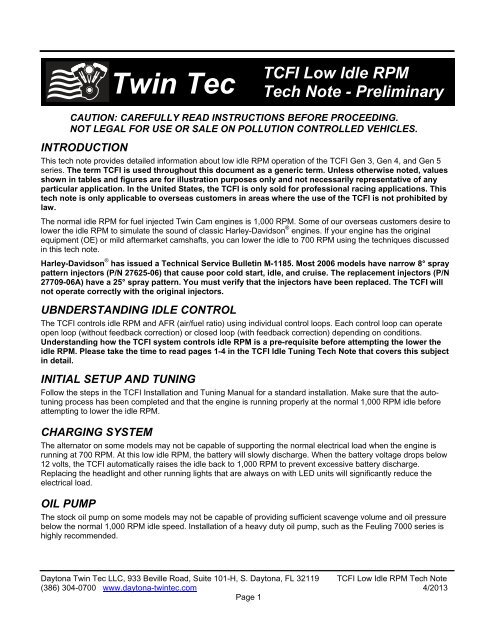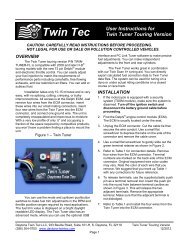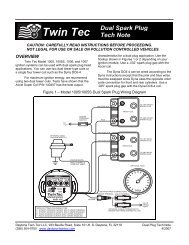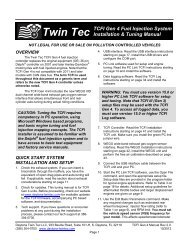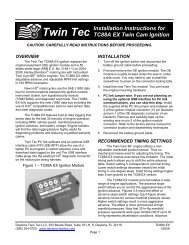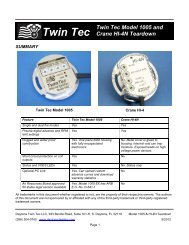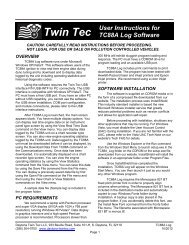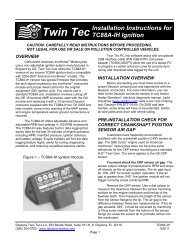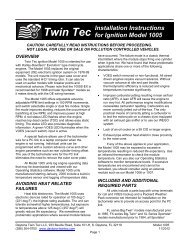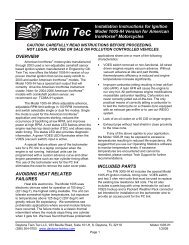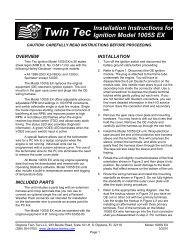TCFI Low Idle RPM Tech Note - Daytona Twin Tec
TCFI Low Idle RPM Tech Note - Daytona Twin Tec
TCFI Low Idle RPM Tech Note - Daytona Twin Tec
Create successful ePaper yourself
Turn your PDF publications into a flip-book with our unique Google optimized e-Paper software.
<strong>Twin</strong> <strong>Tec</strong><br />
<strong>TCFI</strong> <strong>Low</strong> <strong>Idle</strong> <strong>RPM</strong><br />
<strong><strong>Tec</strong>h</strong> <strong>Note</strong> - Preliminary<br />
CAUTION: CAREFULLY READ INSTRUCTIONS BEFORE PROCEEDING.<br />
NOT LEGAL FOR USE OR SALE ON POLLUTION CONTROLLED VEHICLES.<br />
INTRODUCTION<br />
This tech note provides detailed information about low idle <strong>RPM</strong> operation of the <strong>TCFI</strong> Gen 3, Gen 4, and Gen 5<br />
series. The term <strong>TCFI</strong> is used throughout this document as a generic term. Unless otherwise noted, values<br />
shown in tables and figures are for illustration purposes only and not necessarily representative of any<br />
particular application. In the United States, the <strong>TCFI</strong> is only sold for professional racing applications. This<br />
tech note is only applicable to overseas customers in areas where the use of the <strong>TCFI</strong> is not prohibited by<br />
law.<br />
The normal idle <strong>RPM</strong> for fuel injected <strong>Twin</strong> Cam engines is 1,000 <strong>RPM</strong>. Some of our overseas customers desire to<br />
lower the idle <strong>RPM</strong> to simulate the sound of classic Harley-Davidson ® engines. If your engine has the original<br />
equipment (OE) or mild aftermarket camshafts, you can lower the idle to 700 <strong>RPM</strong> using the techniques discussed<br />
in this tech note.<br />
Harley-Davidson ® has issued a <strong><strong>Tec</strong>h</strong>nical Service Bulletin M-1185. Most 2006 models have narrow 8° spray<br />
pattern injectors (P/N 27625-06) that cause poor cold start, idle, and cruise. The replacement injectors (P/N<br />
27709-06A) have a 25° spray pattern. You must verify that the injectors have been replaced. The <strong>TCFI</strong> will<br />
not operate correctly with the original injectors.<br />
UBNDERSTANDING IDLE CONTROL<br />
The <strong>TCFI</strong> controls idle <strong>RPM</strong> and AFR (air/fuel ratio) using individual control loops. Each control loop can operate<br />
open loop (without feedback correction) or closed loop (with feedback correction) depending on conditions.<br />
Understanding how the <strong>TCFI</strong> system controls idle <strong>RPM</strong> is a pre-requisite before attempting the lower the<br />
idle <strong>RPM</strong>. Please take the time to read pages 1-4 in the <strong>TCFI</strong> <strong>Idle</strong> Tuning <strong><strong>Tec</strong>h</strong> <strong>Note</strong> that covers this subject<br />
in detail.<br />
INITIAL SETUP AND TUNING<br />
Follow the steps in the <strong>TCFI</strong> Installation and Tuning Manual for a standard installation. Make sure that the autotuning<br />
process has been completed and that the engine is running properly at the normal 1,000 <strong>RPM</strong> idle before<br />
attempting to lower the idle <strong>RPM</strong>.<br />
CHARGING SYSTEM<br />
The alternator on some models may not be capable of supporting the normal electrical load when the engine is<br />
running at 700 <strong>RPM</strong>. At this low idle <strong>RPM</strong>, the battery will slowly discharge. When the battery voltage drops below<br />
12 volts, the <strong>TCFI</strong> automatically raises the idle back to 1,000 <strong>RPM</strong> to prevent excessive battery discharge.<br />
Replacing the headlight and other running lights that are always on with LED units will significantly reduce the<br />
electrical load.<br />
OIL PUMP<br />
The stock oil pump on some models may not be capable of providing sufficient scavenge volume and oil pressure<br />
below the normal 1,000 <strong>RPM</strong> idle speed. Installation of a heavy duty oil pump, such as the Feuling 7000 series is<br />
highly recommended.<br />
<strong>Daytona</strong> <strong>Twin</strong> <strong>Tec</strong> LLC, 933 Beville Road, Suite 101-H, S. <strong>Daytona</strong>, FL 32119 <strong>TCFI</strong> <strong>Low</strong> <strong>Idle</strong> <strong>RPM</strong> <strong><strong>Tec</strong>h</strong> <strong>Note</strong><br />
(386) 304-0700 www.daytona-twintec.com 4/2013<br />
Page 1
MODIFYING SETUP FOR LOW IDLE <strong>RPM</strong><br />
1. The first step is to verify that the engine will run at the lower idle <strong>RPM</strong>. Download and open the existing<br />
setup file. For reference, print out the ET Based <strong>Idle</strong> <strong>RPM</strong>, ET Based IAC Position and Advance tables<br />
(Tables 1-3 below are examples). Edit the ET Based <strong>Idle</strong> <strong>RPM</strong> table as shown in Table 4. <strong>Note</strong> that the idle<br />
<strong>RPM</strong> values at 64º C and higher are modified. We recommend not modifying any of the values at lower<br />
temperatures.<br />
2. To assure stable engine operation at the lower idle <strong>RPM</strong>, we recommend flattening out the ignition advance<br />
table in the idle range. If ignition advance increases from 500 to 1,000 <strong>RPM</strong>, engine <strong>RPM</strong> may tend to vary<br />
up and down. Table 5 shows the flattened advance that we used on our test motorcycles. Reducing the<br />
ignition advance at the desired idle <strong>RPM</strong> also helps keep the IAC value within a reasonable operating<br />
range.<br />
3. Upload the modified setup file and start the engine. Use the <strong>TCFI</strong> Log software to monitor engine operation<br />
as the engine warms up. Allow the engine to reach at least 112º C. Verify that the IAC value doesn’t<br />
drop below the normal operating range, i.e. below 20. If the IAC value drops below 20, you have two<br />
options: further reduce ignition advance or adjust the idle stop on the throttle body. Adjusting the idle stop<br />
on stock throttle bodies usually requires drilling out the tamper-proof screw and tapping the hole for a<br />
slightly larger set screw. If the idle stop setting allows the throttle blade to completely close and contact the<br />
throttle bore, the blade may bind while cold. If you adjust the idle stop screw, you must also check to make<br />
sure that the throttle blade is not binding when cold. If you adjust the idle stop, you may also have to<br />
readjust the TPS sensor to assure that the TPS voltage remains within 0.30-0.80 volts at idle.<br />
4. The next step is to optimize the ET Based IAC Position table for lower <strong>RPM</strong> operation. Allow the engine to<br />
cool down (we recommend overnight). Start the engine and allow it to reach at least 112º C. Download the<br />
last 24 minutes (this is usually sufficient) of operating data with the <strong>TCFI</strong> Log software. In the chart display,<br />
click on ET and IAC for the cold start as shown in Figure 1. The worksheet shown in Table 6 shows data<br />
obtained from the chart. Use the blank worksheet on page 6 and fill in your data, using the procedure in<br />
steps 5-11 below.<br />
5. The lowest temperature data will depend on your conditions. During the summer months, it may not be<br />
possible to obtain data at 16º C (61º F). In this case, start at 32º C.<br />
6. Fill in the second row of the worksheet with the original IAC values from the ET Based IAC Position table<br />
you printed out in step 1.<br />
7. Fill in the third row with the observed IAC values from your cold start, starting at the lowest temperature<br />
(either 16º C or 32º C) and up to 112º C.<br />
8. The observed IAC value at 112º C (24 in our example) will be the nominal IAC value that the engine runs at<br />
once it reaches normal operating temperature.<br />
9. To obtain the calculated values (bottom row) for your modified ET Based IAC Position Table, subtract the<br />
value at 112º C from all of the observed values in the third row. The calculated value should be zero at<br />
112º C and all higher temperatures.<br />
10. The last step in the calculation is to estimate the correct IAC values at low temperatures where observed<br />
values are not available. The IAC value increases at lower temperatures. On the second row, IAC<br />
increases 15 steps between 16º C and 0º C and an additional 15 steps between 0º C and -16º C. These<br />
same increases in IAC were used to estimate the values in the bottom row at 0º C and -16º C. Use your<br />
own values when doing your worksheet.<br />
11. Once you have completed your worksheet, use the calculated values in the bottom row for your modified<br />
ET Based IAC Position table. Use the observed value at 112º C as new Nominal <strong>Idle</strong> IAC Steps value (on<br />
the Basic Modules Parameters screen). Edit and upload the setup file.<br />
<strong>Daytona</strong> <strong>Twin</strong> <strong>Tec</strong> LLC, 933 Beville Road, Suite 101-H, S. <strong>Daytona</strong>, FL 32119 <strong>TCFI</strong> <strong>Low</strong> <strong>Idle</strong> <strong>RPM</strong> <strong><strong>Tec</strong>h</strong> <strong>Note</strong><br />
(386) 304-0700 www.daytona-twintec.com 4/2013<br />
Page 2
Table 1 – Original ET Based <strong>Idle</strong> <strong>RPM</strong><br />
Table 2 – Original ET Based IAC Position<br />
Table 3 – Original Ignition Advance<br />
<strong>Daytona</strong> <strong>Twin</strong> <strong>Tec</strong> LLC, 933 Beville Road, Suite 101-H, S. <strong>Daytona</strong>, FL 32119 <strong>TCFI</strong> <strong>Low</strong> <strong>Idle</strong> <strong>RPM</strong> <strong><strong>Tec</strong>h</strong> <strong>Note</strong><br />
(386) 304-0700 www.daytona-twintec.com 4/2013<br />
Page 3
Table 4 – Modified ET Based <strong>Idle</strong> <strong>RPM</strong><br />
Table 5 – Modified Ignition Advance<br />
<strong>Daytona</strong> <strong>Twin</strong> <strong>Tec</strong> LLC, 933 Beville Road, Suite 101-H, S. <strong>Daytona</strong>, FL 32119 <strong>TCFI</strong> <strong>Low</strong> <strong>Idle</strong> <strong>RPM</strong> <strong><strong>Tec</strong>h</strong> <strong>Note</strong><br />
(386) 304-0700 www.daytona-twintec.com 4/2013<br />
Page 4
Figure 1 – Logged ET and IAC Data from Cold Start<br />
Table 6 – ET Based IAC Position Worksheet<br />
ET (deg C) -16 0 16 32 48 64 80 96 112<br />
Original IAC Values<br />
(from Table 2)<br />
Observed IAC Values<br />
(from Figure 1)<br />
Calculated IAC Values<br />
(for Modified Table 7)<br />
60 45 30 15 8 5 3 2 0<br />
68 54 46 40 28 26 24<br />
74 59 44 30 22 16 4 2 0<br />
Table 7 – Modified ET Based IAC Position<br />
ADDITIONAL CONSIDERATIONS<br />
<strong>Low</strong>ering the idle below 1,000 <strong>RPM</strong> is somewhat of an R&D project, since Harley-Davidson ® didn’t intend<br />
their <strong>Twin</strong> Cam engines to run at a lower <strong>RPM</strong>. We were able to successfully use the procedure explained above<br />
on two test motorcycles, a 2007 Softail ® with 103 CID engine and stage 3 modifications and a 2012 Softail ® with<br />
103 CID engine and stage 2 modifications. If you run into issues, need help with the worksheet, or have questions,<br />
please email us at techsupport@daytona-twintec.com. Attach your setup file and logged data from the cold start.<br />
Some additional considerations are listed below:<br />
<strong>Daytona</strong> <strong>Twin</strong> <strong>Tec</strong> LLC, 933 Beville Road, Suite 101-H, S. <strong>Daytona</strong>, FL 32119 <strong>TCFI</strong> <strong>Low</strong> <strong>Idle</strong> <strong>RPM</strong> <strong><strong>Tec</strong>h</strong> <strong>Note</strong><br />
(386) 304-0700 www.daytona-twintec.com 4/2013<br />
Page 5
1. Battery voltage drop during cold start test (step 4 on page 2). Since the engine will be running for<br />
about 8-10 minutes at a low idle <strong>RPM</strong>, the battery may discharge below 12 volts on touring models with<br />
heavy electrical loads. As explained on page 1, the <strong>TCFI</strong> will then raise the idle back to 1,000 <strong>RPM</strong>,<br />
defeating the purpose of the cold start test. To avoid this scenario, leave a battery charger connected<br />
during the cold start test.<br />
2. Exhaust considerations. Customers continue to ignore our warnings about using open exhausts with<br />
an auto-tuning system. If the exhaust system is marginal as far as reversion effects at 1,000 <strong>RPM</strong>, the<br />
situation is only going to be worse at 700 <strong>RPM</strong>.<br />
3. Forbidden idle <strong>RPM</strong> zones. 700 <strong>RPM</strong> has been tested without any issues. If you want to try a different<br />
idle <strong>RPM</strong>, do not pick values that are close to the border between <strong>RPM</strong> cells, i.e. 625 <strong>RPM</strong> or 875 <strong>RPM</strong>.<br />
If the engine operates right at the border between two cells, a phenomena referred to as “aliasing” can<br />
cause auto-tuning to fail as one cell becomes progressively leaner and the adjacent cell becomes<br />
progressively richer.<br />
4. Cold start enrichment. If the engine tends to stall a few seconds after initial start, you may have to<br />
adjust the 2D cold start enrichment tables. Refer to the <strong>TCFI</strong> <strong>Idle</strong> Tuning <strong><strong>Tec</strong>h</strong> <strong>Note</strong> for details.<br />
5. Oil pressure and scavenging check. We recommend installing an oil pressure gauge – at least during<br />
the initial tuning phase. If oil pressure drops below 3-5 psi, engine damage may occur. If the engine stalls<br />
for no apparent reason after prolonged low <strong>RPM</strong> idle, check the engine oil sump for excessive oil<br />
accumulation. If this occurs, the only solution is to install a heavy duty oil pump.<br />
Blank ET Based IAC Position Worksheet<br />
ET (deg C) -16 0 16 32 48 64 80 96 112<br />
Original IAC Values<br />
Observed IAC Values<br />
Calculated IAC Values<br />
<strong>Daytona</strong> <strong>Twin</strong> <strong>Tec</strong> LLC, 933 Beville Road, Suite 101-H, S. <strong>Daytona</strong>, FL 32119 <strong>TCFI</strong> <strong>Low</strong> <strong>Idle</strong> <strong>RPM</strong> <strong><strong>Tec</strong>h</strong> <strong>Note</strong><br />
(386) 304-0700 www.daytona-twintec.com 4/2013<br />
Page 6


